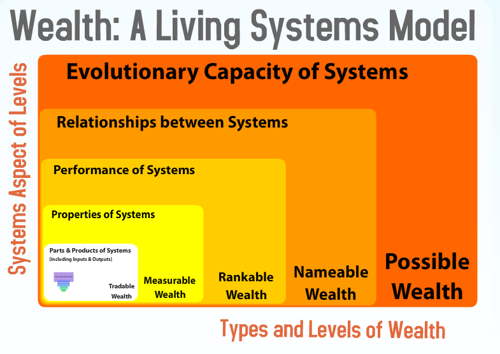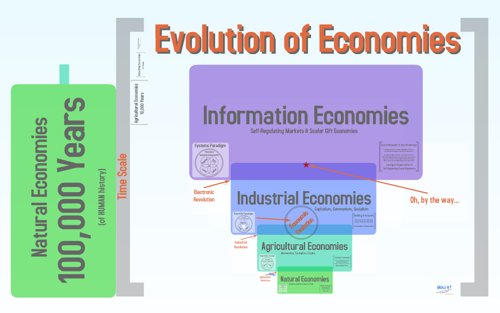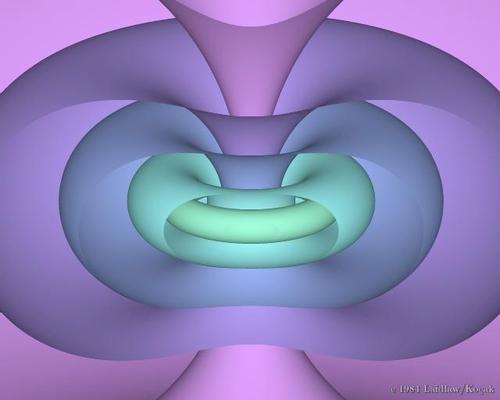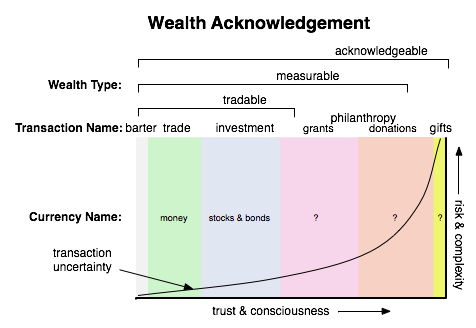WealthMapping
Need to develop a process for groups to explore what wealth means for them. Starting with some notes and maps we have been developing. Just a place to start from and refactor ...
Notes Oct 22, 2009
From Metacurrency call (Art, Eric, Ethan, me):
The idea of turning the usual wealth map over and starting from the field of the possible and building up.
Systems Levels:
Eschelon
We have developed a number of pictures/models to describe the kinds of wealth created by systems. These models inevitably involve nested elements pictured as circles within circles (or boxes in boxes). To quote Dewey, this is not like marbles in a box, but like events are in a history. We are calling these levels "eschelons" both to indicate this sort of containment by the whole, and that within each exchelon many levels and kinds of expressive capacity will arise as well.
This is a source document: Art's Prezi, and several key images below show the inside out view, that is before The Systems Flip.
Systems Wealth

Economic Wealth

Levels of Wealth
Wealth in a Nutshell
Wealth is access to well-being. There are at least three levels of wealth:

- Tradable Wealth: Food, shelter, services, time, are all forms of tradable wealth. We are all familiar with tradable wealth--it is the stuff we need and want, the resources that we compete for. Things we can trade are the products or the components of systems.
- Measurable Wealth: My health is non-tradable--I can't give it to you. I can give you my blood, which may affect both of our health, but I can't give you my health itself. It is a property of my body as a whole. However, you can measure my health in lots of objective ways: the miles I run or the number of times I see a doctor. Another thing that is non-tradable is the productive capacity of a factory. I can sell you the products of the factory, or the factory itself, but not its productive capacity. But you can measure its productivity by comparing its output to the inputs it requires. Similarly the health of a forest is non-tradable. Its diversity, resilience, etc. can, as with bodily health and productive capacity, be affected and objectively measured, but it can't be traded. Bodies, factories, and forests are all examples of systems. Things we can measure but not trade are properties of systems as a whole.
- Acknowledgeable Wealth: Friendship, beauty, freedom, civility, culture, happiness, integrity, reputation--these are all forms of acknowledgeable wealth. They are neither tradable nor objectively measurable because their impact is only felt subjectively. I can have friendships of different strengths--from an acquaintance to a best buddy--and though I can tell the qualitative difference between them, that difference is not measurable using any external scale. Rather, it is a difference in quality of relationship between one system (me) and two other systems (my acquaintance, and my buddy). Similarly my professional reputation comes from my relationships with my previous clients. As a potential client you can get a subjective sense of my reputation by talking to my previous clients, but there is no one objective standard to go by in making your choice. Those things that we can acknowledge but cannot measure or trade are inter-systemic resonances.
These levels of wealth are interdependent. Many communities are resource-poor but health- and culture-rich, but this is only possible up to a point: at some point lack of resources will degrade health and culture. Communities that are resource-rich but don't maintain their other levels of wealth will eventually degrade their capacity to maintain their tradable wealth.
Another Possible Form for Illustrating the Levels

We noted that this way of looking at wealth with parts on the innermost level is more oriented to how we first encounter currencies in the trade of what might be called "detached wealth" or resources. This is to say that we can only trade something as a resource, not as a living system or wealth. Economies develop in this direction where the next Eschelon and on up we are looking as systems in-situ, how we find them. You can't trade a systems property like your knowledge and experience or your physical abilities, but you can trade on them. High quality in terms of relative performance and measurable properties can generate more wealth. But this analysis is from the point of view of use, not the systems themselves.
Wealth Acknowledgment
When I barter a dozen of my eggs for a pound of your carrots, wealth acknowledgment happens in the act of haggling: It's where we determined how many eggs for how many carrots. When I pay you a coin for your carrots instead (because you don't want my eggs), the coin itself is the acknowledgment of the wealth transfer. The advantage is that the wealth-acknowledgment token, the coin, is redeemable elsewhere in the community. And when communities start using paper notes as wealth-acknowledgment tokens instead of precious metal, the number of transactions is no longer limited by the amount of metal available. When communities invent wealth-acknowledgment tokens for investment, like stock certificates sold by entrepreneurs, they further unlock the potential for growth of wealth.
These examples show how the evolution of wealth-acknowledgment systems prepares the ground for the growth of wealth. They also show how wealth-acknowledgment systems are adopted by communities to reduce their risk in making transactions. Bartering is not risky because the wealth is immediately exchanged, but what if I don't need your carrots? Accepting a token allows me to give without immediately getting wealth in return, because I know I can use the token to get wealth later. Stocks and bonds work similarly in higher-risk situations. Thus wealth-acknowledgment systems evolve in a feedback spiral with social cohesion and trust. They require some level of trust and cohesion to function, but they generate much greater cohesion and trust, which allows new wealth-acknowledgment systems, and the loop continues.
Grant-making, endowments, charitable trusts, and donations (what we call philanthropy), are all efforts to increase measurable or acknowledgeable wealth. Organizations that seek to increase measurable and acknowledgeable wealth in communities almost always suffer from the lack of money. To increase our ability to cultivate these levels of wealth, we need a wealth-acknowledgment system that moves beyond money.
Why do we need open money?

- Modern money is inefficient and unfair. Because communities cannot create their own currencies they are beholden to, and fundamentally controlled by, whoever does, just as users of coins were limited by the amount of precious metal available. When communities can create their own currencies, they don't have to export their own wealth to get money to use for trade. They can start trading right away and export later if they so choose.
- "Money can't buy me love." The structure of the modern monetary system is based on assumptions of competition & resource scarcity. Though these assumptions can be applied to tradable wealth, they blind us when we apply them to only measurable or acknowledgeable wealth. To cultivate the kinds of wealth that correspond with overall systemic health and inter-system resonances, where the assumptions of scarcity and competition no longer apply, we need a new wealth-acknowledgment system.
- Our culture and our planet are falling apart. Humanity has grown so large and complex that cultural systems that once maintained the health of our communities no longer can. Similarly, the effects of humanity on the planetary ecosystem are beyond the ecosystems capacity to self-repair. Humanity must take responsibility itself, but currently has no tool and no capacity sufficient to the need for collective action.
How does open money work?
Throughout history, wealth acknowledgment evolved by becoming more abstract and less substantial. Open money follows this same pattern by being a meta-currency system, not just a new single kind of money. It enables the creation of many new types of money. It puts currency creation directly in the hands of communities so that they can create wealth-acknowledgment systems for tracking all types of wealth--tradable, measurable, and acknowledgeable--and so that they can tailor the tracking to fit their precise needs.
Open money works by providing a unified platform for the interchange of all these different kinds of wealth acknowledgment, just the same way that the Internet provides a unified platform for the interchange of all kinds of information. Just as the great shift of the Internet was in not specifying what kind of data can flow across it (unlike the phone network), the great shift of open money lies in not dictating which new form of wealth-acknowledgment people should use. Instead it provides the basic building blocks for communities to create new types of wealth-acknowledgment systems themselves.
Right off the bat, communities can use open money for simple things like Local Exchange Trading Systems (LETS), Time Banks, barter networks, carbon-emissions trading programs, baby-sitting co-ops, reputation tracking systems, business loyalty programs, etc. But the interesting stuff will happen when communities apply their creativity to invent new currencies that solve wealth-acknowledgment problems we don't even have names for yet.
Further Reading
Michael Linton's writings on open money: openmoney.editme.com & openmoney.org and on LETS
Collective intelligence and money: The Transitioner
Community currency background reading: E. F. Schumacher Society
The Systems Flip
Starting from the Possible, undifferentiated potentiality, the living world constructs itself. This is the systems view, the evolutionary view of history. Without trying to explain it, the origin of time in big bang, the world begins in Chaos and any organization is local or short lived. There are no names or membranes, only undifferenciated capacity. We take it as a given that this level is grounded on the unknowable ground of being, and the source of all that is. Whatever you call it, this, the source of all being is both timeless and unlimited. All being derives from this and therefore contains an infinite potentiality within it.
This unity divides into multiplicities as membrans form systems are differenciated and later identified when a self, an object or an I, creates a membrane between self and other. Now from self and other there is a third, the connection or relationship between them, the third is the membrane which we can associate with the sign. This echelon of systems capacity is where the expressive power of systems appear, as new possibilities of symbolic expression and evolution become possible.
All of this is inherent possible in the first echelon, and the first is the source of the creative capacities of our now differentiating systems. The emergent echelons do not supercede the lower ones, but simply add capacities to what was already present. They were possible, but unexpressed in the previous one. The world has to evolve to a certain point where it gains the capacity to differentiate into systems, and this capacity to differentiate, and later with the emergence of language to know your own soul and self as other. The emergence of a new level or even a whole new eschelon creates a new space for beings with this new capacity to interact in complex ways continually evolve more capacities and new levels. This echelon involves the capacity to evolve, and its wealth comes from the expressive capacity of its naming systems (languages).
Many levels and systems of expressive capacity had to evolve before we get to digital information systems, but we can see how it is exists in potential within the core of human language that has been with us for as long as we have been human. The way we have described this it starts with physical processes that give is quarks, atoms, electrons and on up to molecules, planet, galexies, then includes whole hierachies for living systems. Semiosis, the processes described in a paragraph above as the emergence of the second eschelon is identifiable at many levels in the evolving and emerging world living system (Gaia?), and we can see it n the building up from DNA, RNA and amino acid based languages and eventually to social systems and human culture. In some ways, the rest of the eschelons are just elaborations of this, what we could call the semiotic eschelon. We can see that nature has already evolved quite a diversity of systems, or more properly, subsystems of a unified world system. Each of the languages spoken within this highly patterned if seemingly chaotic world of sign is constantly interacting and co-evolving with the other parts it encounters.
It isn't that human culture and language are unique in having language, but in being a creature of language. For most other systems the languages are part of the operations, not facilities for self-understanding. We see ourselves as differentiated from the world, other than the world, in a way that other creatures are not. We don't just get named, we do the naming in the domain of human language and culture.
The frog doesn't go after the fly by thinking up hunting strategies, evolution did that for her and her brain has recognition circuits that trigger a self-correcting (learning) program that feeds the frog. The monkey goes after the bright colored fruit because this is an evolved signal between monkeys and fruit trees, not because it understands why any of this is so. It has fears that are evolved from signals that allowed its ancestors to escape a predator. Language gives humans a new evolutionary space, culture and history, and written language and other tools enhance the evolutionary capacity of human language and culture. We have similar evolved biological capacities, but we also have abilities to supress the instinctual responses with learned behaviors, and to contemplate the learning process and what is to be learned.
sign
These are very close to 1) self, 2) membrane and 3) other of the Nameable wealth eschelon.